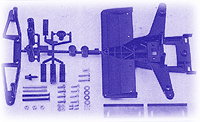Restoration of Tamiya cars
Plastic parts
The truth of the matter is that there’s not much you can do to restore plastic pieces. They’re either broken or they’re not. I’ve seen about a zillion cars where people have tried everything from piano wire to epoxy to duct tape in an effort to repair a broken plastic part.
 For display purposes, it’ll hold together but it’ll look butt-ugly. If you’re actually driving the car I can guarantee that it will not last. You have to keep in mind that most plastic parts that break, break because they were subject to impact forces. Bumpers, suspension arms, shock towers and front gear boxes typically. Well guess what? They’re probably going to experience those same forces again once you blue them back together and get them on the car again.
For display purposes, it’ll hold together but it’ll look butt-ugly. If you’re actually driving the car I can guarantee that it will not last. You have to keep in mind that most plastic parts that break, break because they were subject to impact forces. Bumpers, suspension arms, shock towers and front gear boxes typically. Well guess what? They’re probably going to experience those same forces again once you blue them back together and get them on the car again.
My recommendation is to simply replace any broken part with a new one.
Scratches and surface abrasion can’t be really fixed either. I’ve tried a few plastic polishes but I don’t find them effective at taking out scratches. They seem to introduce a zillion more minor scratches and generally dull the surface of the piece! What I have found though is that for display purposes, low-gloss Armor All works like a wax on black Tamiya plastic.
It darkens the black color making it appear richer. At the same time, it seems to "hide" minor surface imperfections fairly well. Again, this is really for display purposes only. There’s no value in using Armor All if you intend on running the vehicle.
Other issues that come up are plastic parts that fall out of tolerance. For example, a common problem with older Tamiya kits are suspension arm shaft mounting holes. Over time, the holes open up and a lot of play can be introduced. Some viewers have written to say that a few drops of CA works like a charm. Basically what you do is drop a few drops into the mounting hole and swirl it around with a straightened paper clip. After it dries, the CA will serve to build the hole so that there is less play in the suspension. Sometimes two applications of this procedure are necessary in order to achieve the desired results.
Incidentally this also works well for stripped screw holes in plastic parts as well. One word of caution, ensure that the CA has COMPLETELY dried prior to screwing in a new screw. Otherwise you’re going to find it impossible to remove the screw later.
